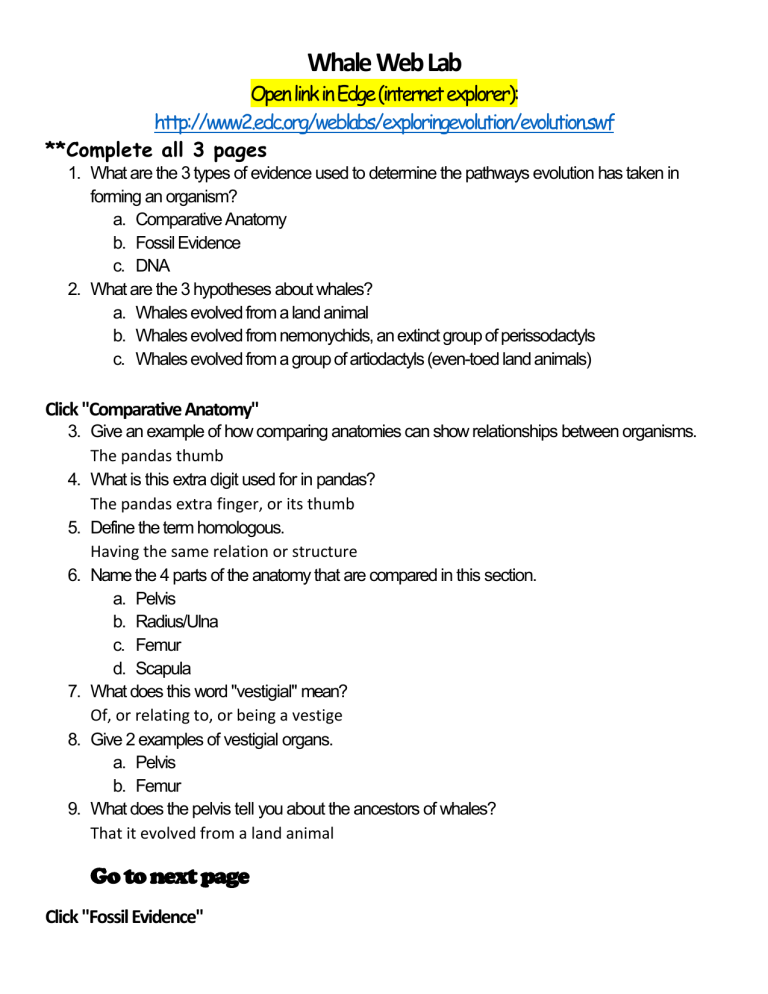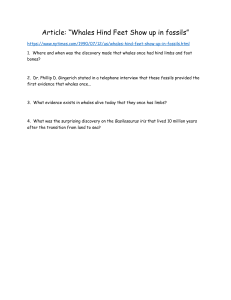
Whale Web Lab Open link in Edge (internet explorer): http://www2.edc.org/weblabs/exploringevolution/evolution.swf **Complete all 3 pages 1. What are the 3 types of evidence used to determine the pathways evolution has taken in forming an organism? a. Comparative Anatomy b. Fossil Evidence c. DNA 2. What are the 3 hypotheses about whales? a. Whales evolved from a land animal b. Whales evolved from nemonychids, an extinct group of perissodactyls c. Whales evolved from a group of artiodactyls (even-toed land animals) Click "Comparative Anatomy" 3. Give an example of how comparing anatomies can show relationships between organisms. The pandas thumb 4. What is this extra digit used for in pandas? The pandas extra finger, or its thumb 5. Define the term homologous. Having the same relation or structure 6. Name the 4 parts of the anatomy that are compared in this section. a. Pelvis b. Radius/Ulna c. Femur d. Scapula 7. What does this word "vestigial" mean? Of, or relating to, or being a vestige 8. Give 2 examples of vestigial organs. a. Pelvis b. Femur 9. What does the pelvis tell you about the ancestors of whales? That it evolved from a land animal Go to next page Click "Fossil Evidence" 10. What is something else besides rock that could be said to have strata? Lasagna 11. What is the "Law of Superposition"? Older rocks are generally found below younger rocks 12. Name the 4 fossils you found and tell how old they are. a. Pakicetus – 50 million years old b. Mesonychid – 60 million years ago c. Ambulocetus – 49 million years ago d. Cetotherium – 15 million years ago Click on the magnifying glass at the bottom of the page and then click "DNA evidence" 13. What is DNA coding? Pattern of amino acids used to build a actual DNA strand 14. What is a perissodactyl? Give some examples of ones that live today. Horse, rhino 15. When did perissodactyls first arise? 60 million years ago 16. Give an example of an extinct perissodactyl. Baluchitherium – largest land mammal ever 17. What is an artiodactyl? Give some examples of ones that live today. Aniamls with even number of toes – goat, giraffe 18. What is an ungulate? Hoofed animals 19. Name 4 characteristics of mammals. a. Whales b. Humans c. Cows d. Dogs Go to next page Click "compare" DNA 20. Which group has the most similar DNA in whales? Lions, cats, and humans Click the check mark at the bottom of the screen and choose a hypothesis that matches all of the data you have collected. 21. Which of the hypotheses have you verified through your studies? That whales evolved from a land animal


